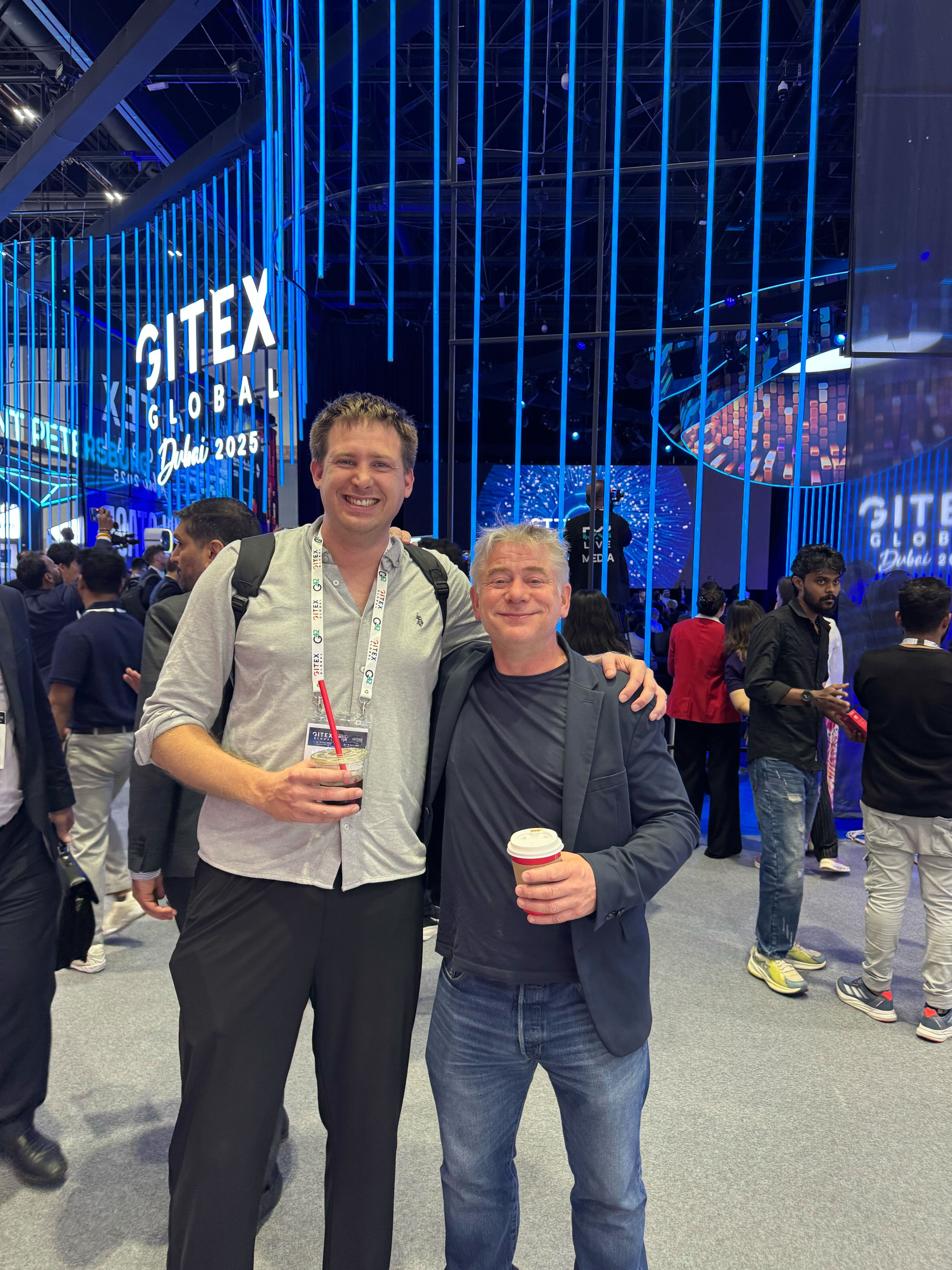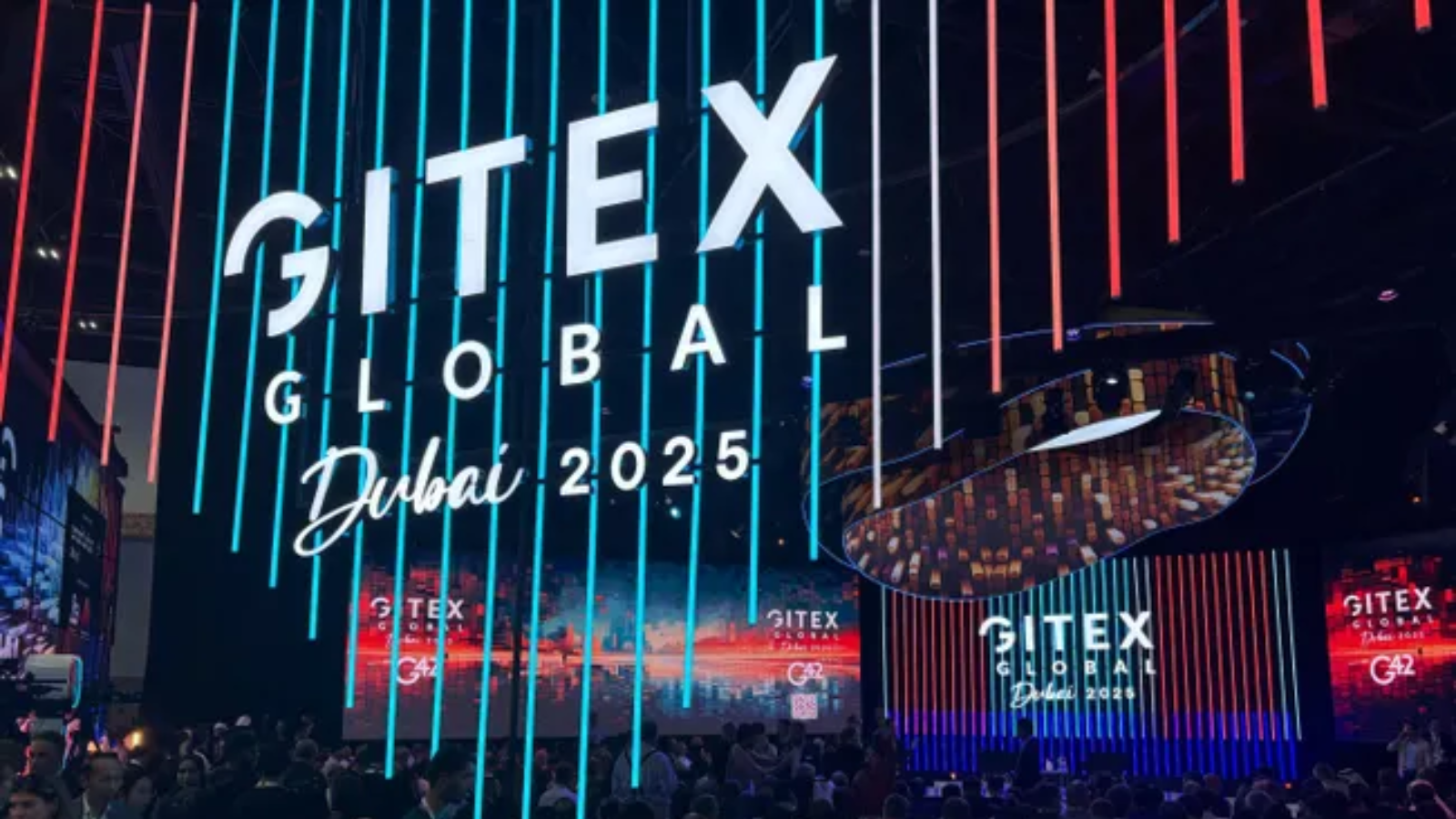I’m at GITEX Global, Dubai, one of if not the biggest tech exhibition in the world. All the big names that you would expect are here, Microsoft, AWS, Google, and of course most are talking about AI. And, part of that conversation is energy. Is there enough, where do we get it from, and how do we get it to where it needs to go? Greg Jackson, Co-founder and CEO of Octopus Energy is here as a speaker to go over those things and just before he got on stage, we grabbed a coffee.
I met Greg just outside the speakers booth as he was humbly negotiating with security to let him back in without a lanyard. The bouncer smiled and we set off to get coffee. The following conversation has been edited slightly to make it a bit more readable. For example, I take out the part where we actually buy coffee.
So, do we have the energy infrastructure needed for AI?
We didn’t have the infrastructure even before AI. There are parts of the UK where you can’t build houses because you can’t get power. So that was the start point. And then AI rocked up with some remarkable forecasts for energy consumption. So, I think, we weren’t even at the start line.
On top of that, we don’t have the markets. If you look at the way that energy works, essentially it’s all based around the idea that the system operators can plan a decade in advance. Then, they can craft the perfect system. But the reality is, three years ago, no one had heard of large language models. They didn’t feature in anyone’s plans. Markets respond quickly to need and change, but regulated grids don’t. So, we don’t have the infrastructure, but neither do we have the signals that let us say, hey, look, how do we use the existing infrastructure better and where should we build new infrastructure?
So how do the regulations need to change?
What we really need to do is capitalize on hyperscalers, who are used to being able to get whatever they want if they can build it or pay for it. There is more capital available now than there has ever been in history for anything. So you simultaneously have this challenge; In the US, you’ve got consumers being told that their energy rates are going to rise to build the infrastructure for AI, and the UK and large parts of Europe have been told we might not get AI at all because our energy is too expensive. And yet, there’s this phenomenal amount of capital available.
So what we need to do is create markets where that capital can be deployed. When I talk about creating markets, it’s enabling the hyperscalers to put their capital to work, building infrastructure that they can use rather than having to wait for regulated entities to decide what they’re going to get.
What’s stopping that from happening?
So, across Europe, the governments created the central plans for energy. Now, the central plan is not going to work. It was already struggling. It’s really not going to work with AI. So what you need to do is, first of all, introduce more price signals. You need prices that vary by location and by time, so that entrepreneurs, businesses, hyperscalers, can work out where they can get the cheapest power and what extra power they can put in the system and what the economics will be.
If you look at Scotland in the UK, the UK has spent a billion pounds so far this year, just turning off wind farms in Scotland and paying for gas to replace it. All that electricity we’re turning off could be used for things like data centers.
Why are they paying to turn it off?
The system operator, which varies by country, runs an auction and gets every generator to bid in the auction. And then they pay them for the electricity they get to generate. However, they do that without looking at the map of the grid. So they pay a wind farm for the electricity, and then they realize there’s grid congestion, that wind farm can’t get its electricity to market. So they tell it not to generate even though it’s been paid for, and then they pay somebody else.
By 2030, the UK will be spending $8 billion a year doing that. All that electricity that we’re not generating, but paying for, could be used to do things like power data centers. In the Industrial Revolution, steelworks were built near the sources of iron ore and coal. In the initial phase of building out grids, power stations were built near the coal fields in the UK, in Germany, around Europe. Now datacenters, the big consumers of energy, should be built where we’ve got the energy. At the moment, you don’t have any kind incentive to build near the energy where it will be cheaper.
How did it get in this situation?
I think there were two things. First of all, the world is changing exponentially. So two or three years ago, no one knew we’d have this demand for electricity. We had a world where electricity demand was changing by one or 2% per year. Suddenly it’s set to explode, and the system and regulations are not built for that.
The second issue is that we, for example, to meet climate goals, we built a whole load of infrastructure for generation without thinking about consumption. And so, for example, in the UK, we’ve built wind farms in the north of Scotland, but all the consumption is in the south of England. So we built the infrastructure in the wrong places. We can fix that. We can build new demand where we’ve built the infrastructure, but only if there are economic incentives to do so. And that would mean giving data centers access to where we’re turning that wind off, we just use it for data centers. Scotland would go from having the most expensive electricity in Europe to just about the cheapest.
Why is energy so expensive?
This isn’t just a UK issue. In every state in the US, I meet the energy regulators and the utilities companies. They all say, there’s this huge demand for AI in our state, and we cannot build the infrastructure without increasing energy bills dramatically. And so again, we need to find a way for these AI companies that have got access to enormous sums of capital to build and deploy their own energy infrastructure quickly.
Instead, the systems are so slow and companies are so desperate that they’re trying to recommission old nuclear plants or build new nuclear fast. But all this stuff is very, very slow. You cannot imagine a new nuclear plant being built in less than five years. And these people need electricity now.
You can build a wind farm in three months, you can build a solar farm in three months. Batteries are so cheap now that here in the UAE, they’ve announced a 24/7 battery and solar plant to generate electricity for data centers that don’t need gas or nuclear power.
Just on batteries?
Yeah. It’s totally possible. I think what’s happening is, because it feels complicated, people are trying to do what sounds simple, rather than muck around trying to balance your batteries and your solar and your wind. They say let’s build a nuclear station (which is also complicated). I think over the last year, I’m beginning to see this realization that there are no silver bullets, it’s going to take some hard work and regulatory reform.
To give you an idea about how outdated the regulated grids are. The cost of grid scale batteries 10 years ago was $1,000 per kilowatt hour. Last year it was $100, this year it’s $52, and it’s projected to get cheaper. The world’s biggest battery company, has announced $10 batteries. The UK regulator, the UK grid, for its planning for 2030 assumes batteries at $300. It is using the 2019 price for a product that is going to fall 100 fold in 15 years.
Now, because they use that assumed figure, instead of making the most of these technologies that are available right now, what they’re doing is they’re kind of building… It’s like building landlines after the invention of the smartphone. And that’s happening in most Western nations.
China, totally different. China’s not worrying about power for AI. In China, if you want to use a lot of electricity, you have to build your own generation and then trade your surplus or your shortfall. By forcing those market mechanisms, they just don’t have the same worry. Whereas in the West, we kind of built this huge dinosaur system, and it couldn’t cope anyway, and it’s screwed now.
Me: That’s the headline!
Greg: Yeah, if you want. I’m not sure it scans. Can a dinosaur system can be screwed?
Me: I’ll paraphrase a little bit.
So what’s the fix?
One of the reasons the Soviet Union collapsed was central planning couldn’t cope. There was this central planning body called Gosplan, and in a world of rapidly changing technology, Gosplan just couldn’t keep up. And in the same way now, the central planning of our grids can’t keep up. So, countries that enable and create market mechanisms that let us take this private capital that’s available in abundance and deploy it fast, are the ones that are going to get the AI infrastructure. So, we really, really need more and more market mechanisms so that people who know that batteries cost $52, not $300 or $400, can deploy those solutions.
Sadly, we all have a tendency when something’s not going well to tighten our grip. Very often what you need to do is to loosen your grip, and that’s what we need. We need regulators and planners to loosen the grip. Let this capital get deployed, use it to speed up the deployment for AI, and in doing so, it can bring down costs for everyone else.
I was with one of the biggest hyperscalers in the world, two weeks ago. And they said, you know, we would happily pay a 30% premium for electricity if we could get it now. And if you use that 30% to pay everybody else to, for example, use it more flexibly or build a different system, we’re fine with that. That’s what we should be doing.
What can we do in the meantime?
When Trump visited the UK a couple of weeks ago, Howard Lutnick, one of his team, said “there was a regulation in Arizona which meant that it would take six to eight months to get a clean air permit for a silicon factory and given that it has no chimney, it really shouldn’t need a clean air permit. So we did it in three days.” And, I think there is a world in which, as governments are under pressure to deliver results…
Greg is interrupted by a panicked phone call from the organizers of GITEX asking him to come back to the speakers area.
So, I say in a world where governments are racing to not miss the AI opportunity, it’s a golden chance to say, look, you know, if you want to win this, you have to change regulation fast. And you can change regulations. It would not just benefit AI, but citizens would benefit from cheaper electricity, more generation, more ability to build things like houses, data centers, and factories that are all currently suffering from lack of electricity.

We reached the main stage. I would have liked to have carried on our conversation but we both had places to be. I shook hands with Greg and thanked him for his time, and the coffee.


